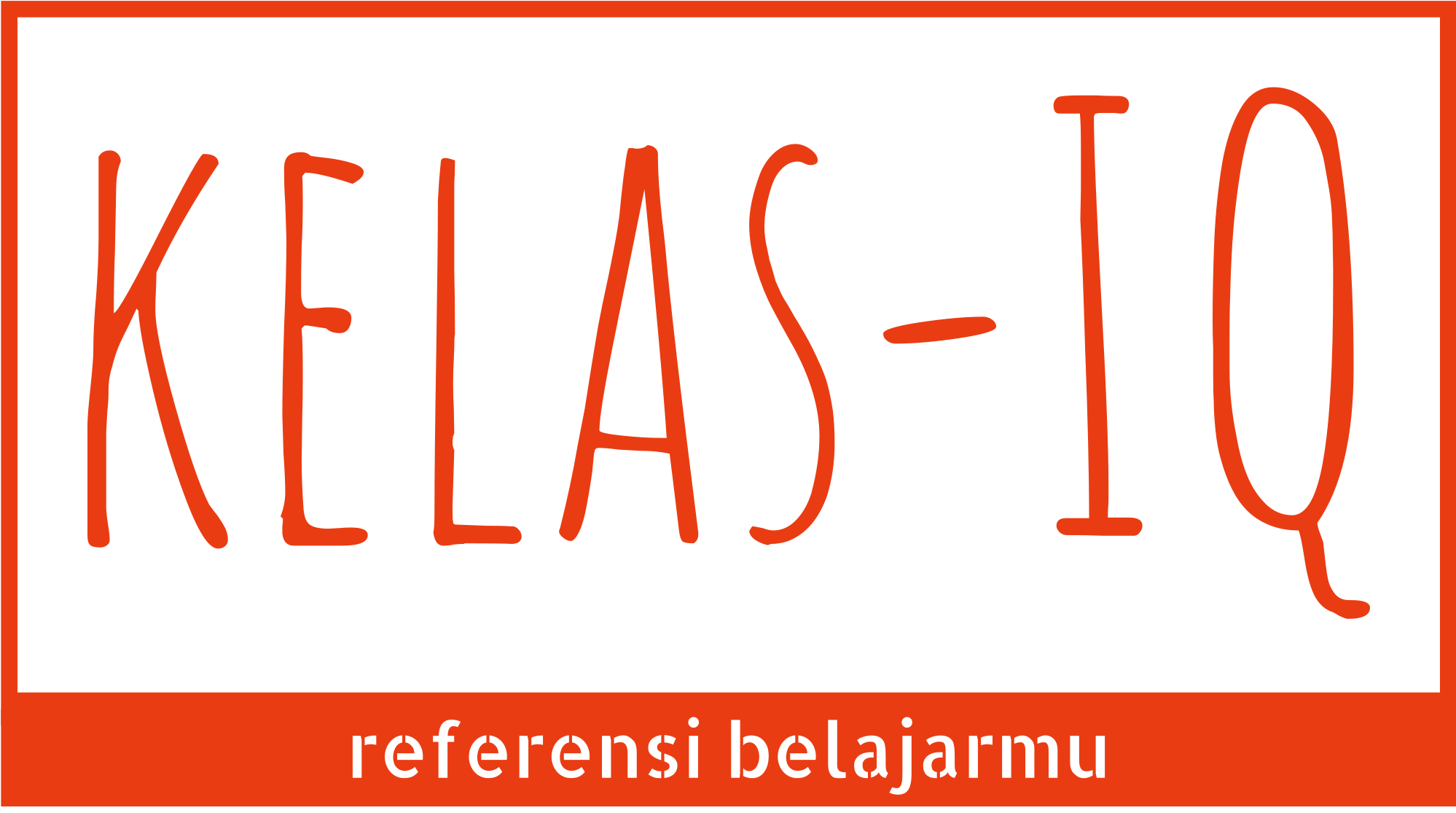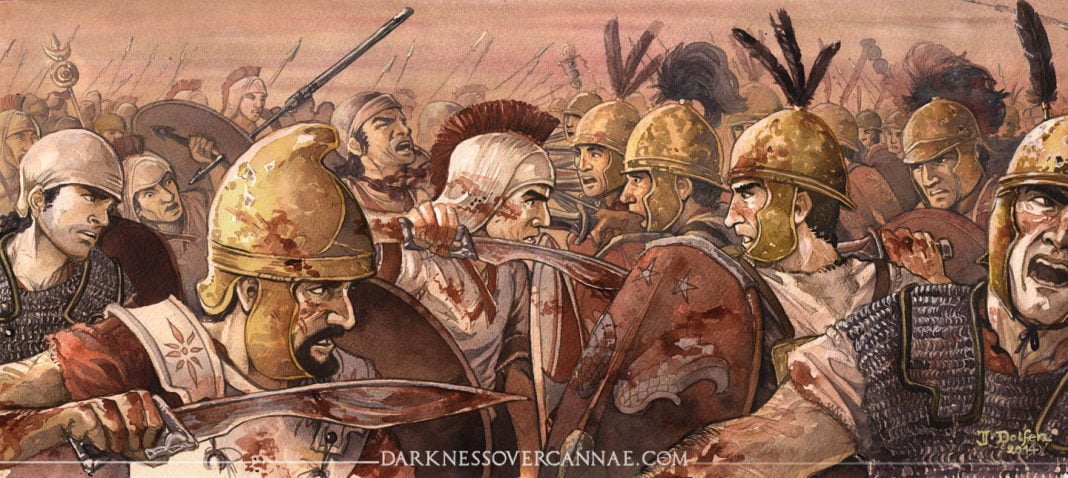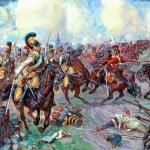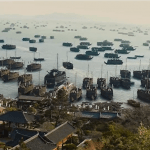Hannibal’s incredible battle of annihilation against the Roman army has been studied throughout history, and many famous generals like Napoleon and Frederick II both regarded it as the greatest tactical achievement of all time.
During the Second Punic War, Hannibal won an incredible victory at the Battle of Lake Trasimene, using a scouting unit as bait to ambush the main enemy force, and bagging his second complete annihilation of a Roman army. (The first was at the Battle of the Trebia River). Following this defeat, the Roman Senate finally realized that they could not directly beat Hannibal in battle. Instead, they adopted a Fabian strategy (named after the leader of the Senate following the defeat, Quintus Fabius Maximus Verrucosus Cunctator) to indirectly weaken him until an army that was sure to crush him was amassed.
Though he certainly could defeat rival armies, Hannibal’s forces lacked the strength and the equipment to directly take Rome at this vulnerable time. Instead, Hannibal rampaged through Italy, pulling reinforcements from towns who defected from Rome.
A year later, the army was ready. Polybius notes that Rome brought in eight legions to battle; never before had Rome massed an army of that size. Every legion was reinforced by an equal number of allied forces. There is much disagreement over the size of Rome’s army, but most estimates put it at over 80,000 freshly equipped men, (three times as much as Hannibal had) ready to fight and die for their homeland.
By this time, Hannibal had an army with limited supplies and faltering morale. Wandering for years in foreign territory had drained their resolve and stirred discontentment in their ranks; only Hannibal’s charisma kept them together.
The two armies met at the plains of Cannae, where the lack of territorial features like there were at the Battle of Lake Trasimene and the Battle of the Trebia River would give an edge to the Roman juggernaut. The night before, Hannibal contemplated an evacuation of his army to avoid complete destruction. If he stayed, the chances of defeat were extremely high, and defeat here would remove victory in the war as a possible outcome and leave Carthage unprotected. If he ran, he could flee from the main Roman army until a favorable location for battle was located.
The next morning, both sides prepared for battle. The Romans deployed in an extremely dense and deep formation; their plan was to quickly break the center of the Carthaginian line and isolate their flanks. Hannibal deployed his forces in a thin line that mirrored the Roman forces; his plan was to contain the Roman frontal attack and strike at their flanks.
Both armies advanced. Hannibal instructed his central forces to retreat when they met the main Roman lines; Gaius Terentius Varro (the Roman commander) saw the Carthaginian center falling back, and instructed his forces to press ahead with their attack. The Roman lines got more and more dense as they attacked the Carthaginian center ever more doggedly. Hannibal’s flank forces stood their ground.
Meanwhile, the Carthaginian cavalry on Hannibal’s left flank charged the Roman cavalry, and after a brief melee, completely defeated them. Then they were diverted to the right flank to defeat the Roman cavalry there as well.
The Roman lines then lost their integrity as they continued to press on the Carthaginian center. Imagine if in Age of Empires 2, you had an enormous block of Teutonic Knights, and you encountered a thin line of enemy infantry. What the Romans were doing is the equivalent of you selecting all of your Teutonic Knights and right-clicking on the center. What happens, and what was happening to the Romans, is that your entire force bunches up and becomes a giant crowd of disorganized people.
This lack of organization was going to cost them dearly.
After completely defeating the Roman cavalry, the Carthaginian cavalry returned to strike the crowd of Roman soldiers in the rear, while the flank infantry turned inward to strike at the Roman flanks.
The Roman force was now completely surrounded.
The horrified Romans were so densely packed that they could not take out their weapons, let alone fight. Tens of thousands die as Hannibal bags his third Roman Army. In the end, the Roman force was almost completely annihilated, while Hannibal had minimal casualties. The entirety of Southern Italy rose up in revolt against Rome.
It is difficult to imagine the panic and terror which Rome felt after this defeat, but Livy gives us an interesting idea of it:
“Never before, while the City itself was still safe, had there been such excitement and panic within its walls. I shall not attempt to describe it, nor will I weaken the reality by going into details… it was not wound upon wound but multiplied disaster that was now announced. For according to the reports two consular armies and two consuls were lost; there was no longer any Roman camp, any general, any single soldier in existence; Apulia, Samnium, almost the whole of Italy lay at Hannibal’s feet. Certainly there is no other nation that would not have succumbed beneath such a weight of calamity.”
The truly amazing thing about this battle, however, is that the Romans still refused to surrender. Like the Vietcong after the Tet Offensive, this defeat only made them fight even harder against the Carthaginians. The Romans would learn from this, and later, they would use some of Hannibal’s strategies against other enemies.
For Hannibal, his strategic situation did not improve. A reinforcement army, with siege equipment, was sent from Carthage, but in one of history’s greatest ironies, the Romans used a tactic learned directly from Cannae to defeat it. And eventually, the grim determination of Rome combined with the genius of a Hannibal fan named Scipio Africanus led Hannibal to a defeat at the Battle of Zama, which ended the war.
The influence of the battle cannot be understated. Tactical knowledge gained from Cannae helped Rome win decisive border battles such as Alesia and Pydna. Other generals, like Napoleon and Gustavus Adolphus, used it as inspiration for their own battle plans. Hannibal’s maneuvers and his ability to turn a victory in detail into a complete victory has been studied by generals of both guerrilla and mechanized warfare. And Cannae was the tactical basis for Germany’s Schlieffen Plan and Schwarzkopf’s Desert Storm.
So overall, I say that Cannae might not be the most epic historical battle of all time, but it certainly is one of the most significant, ranking up there with Marathon, Midway, and Gettysburg. It didn’t have the numbers of Stalingrad or Leipzig, and it didn’t bring victory upon Hannibal, but instead, it earns its position because of its tactical innovation, its massive historical impact, and the truth it reveals about warfare: a tactical victory is not always a strategic victory.



